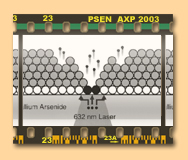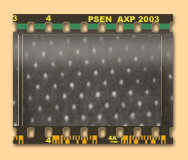

|
|
|
|
|
|
|
|
|
|
|
|
|
|
|
|
|
|
|
|
|
|
|
|
|
|
|
|
|
|
 |
|
Dual Photography Pradeep Sen, Billy Chen, Gaurav Garg, Stephen R. Marschner, Mark Horowitz, Marc Levoy, Hendrik P.A. Lensch Proceedings of SIGGRAPH 2005 We present a novel photographic technique called dual photography, which exploits Helmholtz reciprocity to interchange the lights and cameras in a scene. With a video projector providing structured illumination, reciprocity permits us to generate pictures from the viewpoint of the projector, even though no camera was present at that location. The technique is completely image-based, requiring no knowledge of scene geometry or surface properties, and by its nature automatically includes all transport paths, including shadows, inter-reflections and caustics. In its simplest form, the technique can be used to take photographs without a camera; we demonstrate this by capturing a photograph using a projector and a photo-resistor. If the photo-resistor is replaced by a camera, we can produce a 4D dataset that allows for relighting with 2D incident illumination. Using an array of cameras we can produce a 6D slice of the 8D reflectance field that allows for relighting with arbitrary light fields. Since an array of cameras can operate in parallel without interference, whereas an array of light sources cannot, dual photography is fundamentally a more efficient way to capture such a 6D dataset than a system based on multiple projectors and one camera. As an example, we show how dual photography can be used to capture and relight scenes. |
||
|
|
|||
|
Silhouette Maps for Improved Texture Magnification Pradeep Sen Proceedings of SIGGRAPH/EUROGRAPHICS Graphics Hardware 2004 (Best Paper Award) Texture mapping is a simple way of increasing visual realism without adding geometrical complexity. Because it is a discrete process, it is important to properly filter samples when the sampling rate of the texture differs from that of the final image. This is particularly problematic when the texture is magnified or minified. While reasonable approaches exist to tackle the minified case, few options exist for improving the quality of magnified textures in real-time applications. Most simply bilinearly interpolate between samples, yielding exceedingly blurry textures. In this paper, we address the real-time magnification problem by extending the silhouette map algorithm to general texturing. In particular, we discuss the creation of these silmap textures as well as a simple filtering scheme that allows for viewing at all levels of magnification. The technique was implemented on current graphics hardware and our results show that we can achieve a level of visual quality comparable to that of a much larger texture. |
||
|
|
|||
|
Shadow Silhouette Maps Pradeep Sen, Mike Cammarano, and Pat Hanrahan Proceedings of SIGGRAPH 2003 The most widely used techniques for interactive rendering of hard shadows are shadow maps and shadow volumes. In this paper, we propose the method of silhouette maps, in which a shadow depth map is augmented by storing the locations of representative points on the geometric silhouette. A piece-wise linear approximation to the true silhouette can then be found by applying dual-contouring techniques. The proposed method allows each silhouette map texel to represent a polygonal approximation to the actual shadowing geometry, in contrast to the jagged approximation provided by a conventional shadow map. |
||
|
|
|||
|
Efficient Partitioning of Fragment Shaders for Multipass Rendering on Programmable Graphics Hardware Eric Chan, Ren Ng, Pradeep Sen, Kekoa Proudfoot, and Pat Hanrahan Proceedings of the SIGGRAPH / Eurographics Workshop on Graphics Hardware 2002 (Best Paper Award) Real-time programmable graphics hardware has resource constraints that prevent complex shaders from rendering in a single pass. One way to virtualize these resources is to partition shading computations into multiple passes, each of which satisfies the given constraints. Many such partitions exist for a shader, but it is important to find one that renders efficiently. We present Recursive Dominator Split (RDS), a polynomial-time algorithm that uses a cost model to find near-optimal partitions of arbitrarily complex shaders. Using a simulator, we analyze partitions for architectures with different resource constraints and show that RDS performs well on different graphics architectures. We also demonstrate that shader partitions computed by RDS can run efficiently on programmable graphics hardware available today. |
||
|
|
|||
|
Lifetime and reliability results for a negative electron affinity photocathode
in a demountable vacuum system Pradeep Sen, D. Pickard, J. Schneider, M. McCord, R. Pease, A. Baum, K, Costello Journal of Vacuum Science and Technology B Negative electron affinity photocathodes may have useful applications as electron sources for high-throughput microlithography. However, the nature of such a system has raised questions about the lifetime and reliability of a cathode during operation. In this article, we report on the lifetime and reliability of cathode operation under various conditions applicable to lithography. The 1/ e lifetime of the cathode was measured as a function of the cathode current, which turned out to be an inverse relationship. Lifetime was also found to be a function of initial level of cesiation of the surface and cesium levels during activation. In particular, when the cathode was initially overcesiated, the Faraday cup current (in the plane of the phosphor) was found to be stable to 2% for up to 3 days at 200 nA, indicating that the cesium level that optimizes lifetime is not necessarily the same level that optimizes quantum efficiency. |
||
|
|
|||
|
Patterned negative electron affinity photocathodes for maskless electron
beam lithography J. Schneider, Pradeep Sen, D. Pickard, G. Winograd, M. McCord, R. Pease, W. Spicer, A. Baum, K, Costello, G. Davis Journal of Vacuum Science and Technology B This work focuses on two issues crucial to achieving high throughput with a negative electron affinity semiconductor photocathode source. Monte Carlo simulations indicate that for a 50 kV system, as much as 8 uA of current may be delivered to the wafer to achieve a raw throughput of 20 8 in. wafers per hour with 0.1 um minimum feature size (assuming a resist sensitivity of 10 uC/cm^2). In order to achieve the throughput potential of this approach, suboptical emission areas are required; this suggests the use of cathode patterning. Two patterning alternatives have been investigated experimentally, and both approaches have been used to generate arrays of more than 100 electron beams with source sizes as small as 150 nm. However, each type of patterned cathode presents unique challenges to fabrication and performance in a practical multibeam system. Different source configurations (number of beams, beam current, beam spacing, etc.) create a system-level tradeoff between resolution and throughput. Results from patterned cathode experiments and system modeling are presented. |




